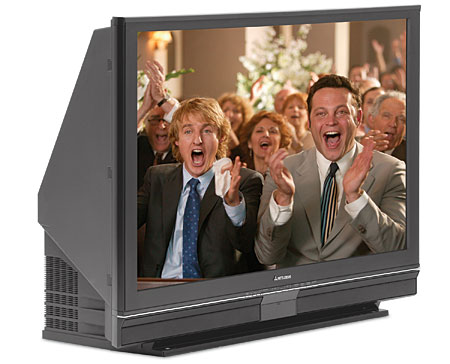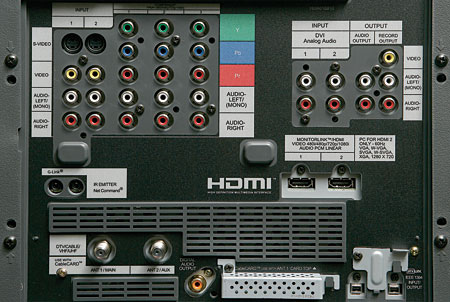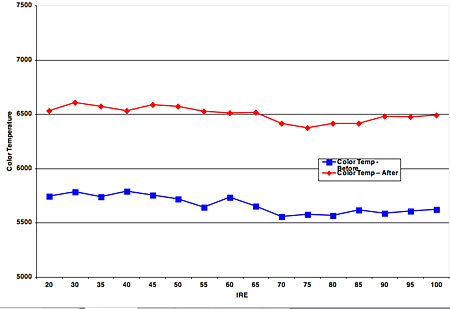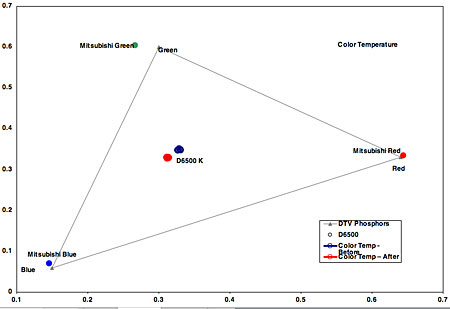The Great 1080p HDTV Face Off Mitsubishi WD-52628
Post-cal accuracy galore.
Next up is the Mitsubishi WD-52628. While it had several strengths, it had two key weaknesses that kept it from placing higher.

First up was the black level. The WD-52628 had the highest black level after the JVC. At 0.030 foot-lamberts, it was by no means high compared with most displays. That just shows how tough the competition was in this Face Off. Its contrast ratio was about mid-pack.

More of an issue was the amount of noise. This came in two forms: a fair amount of what appeared to be quantization error and a graininess in specific portions of the picture. Take chapter 5 of The Fifth Element. Bruce Willis sits up in bed, and the room behind him is dark, but not uniformly so. There is a gradation from light to dark that, on an analog display, would be smooth. Digital displays have many ways of making this look smooth and many ways of making it look messy. There was an obvious step in the background gradation on the WD-52628, and, within this step, there was a lot of noise that was quite visible. In the space portion of the HD content, there was noise in the blackness of outer space. John also commented that this was one of only a couple of TVs that showed specific gradations in the atmosphere. The graininess was most apparent on the WD-52628, although the other DLP sets showed it in lesser degrees. It was most visible on this TV in solid colors.
 As far as video processing and 3:2 pickup went, the WD-52628 finished about mid-pack. There were some jagged edges on the waving-flag test, but they weren't bad.
As far as video processing and 3:2 pickup went, the WD-52628 finished about mid-pack. There were some jagged edges on the waving-flag test, but they weren't bad.
It also didn't help that, out of the box, the TV is very warm. Calibration solved this issue. In fact, after calibration, it was the most accurate of the TVs. The color decoder was also adjustable and, after calibration, yielded very good results. The color points, as far as red and blue go, were pretty much spot-on. Green, on the other hand, was rather bluish-green. This led Adrienne to comment that the image looked slightly turquoise.
Adrienne also referred to the remote as "rather clunky." It is backlit, though. She also didn't like the menus, which were confusing. I have to agree here. While there are adjustments for lots of items, they are spread out over several sections and several different buttons on the remote.
So, all in all, this isn't a bad TV up against some extremely tough competition. If it weren't for the noise issue, this set would probably have nosed out our next contestant.
Highlights
• Excellent ANSI contrast ratio
• Excellent gray-scale tracking after calibration
At A Glance: Mitsubishi WD-52628 Rear-projection HDTV

Connections
Inputs:
Video: HDMI (2), component video (3), S-video (3), composite video (3)
Audio: stereo audio (8)
Outputs:
Video: Composite (1)
Audio: Coaxial (1), stereo audio (2)
Additional: FireWire (3), RF (2), CableCARD (1)
Features
Type: DLP
Screen Size (diagonal): 52 inches
Native Resolution: 1,920 by 1,080
Lamp Life: 6,000–8,000 hours
Dimensions (H x W x D, inches): 34 x 49.6 x 18.6
Weight (pounds): 121
Price: $3,900
Ratings: Mitsubishi WD-52628 Rear-Projection HDTV
Build Quality: 90
Value: 91
Features: 91
Performance: 88
Ergonomics: 87
Overall Rating: 89
General Information
WD-52628 Rear-Projection HDTV, $3,900
Mitsubishi
(800) 332-2119
www.mitsubishi-tv.com
Dealer Locator Code MSU
HT Labs Measures: Mitsubishi WD-52628 Rear-Projection HDTV


Full-On/Full-Off Contrast Ratio—4453:1;
ANSI Contrast Ratio—416:1
Measured Resolution with the Leader LT-446:
480: 480 (per picture height)
720p: 720 (pph)
1080i: 1010 (pph)
DC Restoration (poor, average, good, excellent): Excellent
Color Decoder (poor, average, good, excellent): Good (After adjustment)
Measured Color Points:
Red Color Point: x=0.644, y=0.334
Green Color Point: x=0.267, y=0.604
Blue Color Point: x=0.146, y=0.070
The left chart shows the WD-52628's gray scale relative to its color temperature at various levels of intensity, or brightness (20 IRE is dark gray; 100 IRE is bright white). The gray scale as set by the factory, in the low color-temperature mode, measures warm across the gray scale. After making adjustments using the Photo Research PR-650, the gray scale measures within 124 Kelvin of D6500, the accurate color temperature, across the entire range.
The right chart shows the gray scale (or color temperature) relative to the color points of the display's red, green, and blue color-filter-wheel segments. These are somewhat close to those specified by SMPTE. Red is very slightly oversaturated. Blue is slightly greenish-blue. Green is somewhat bluish-green.
After calibration, and using a full-field 100-IRE white (133.6 foot-lamberts) and a full-field 0-IRE black (0.030 ft-L), the contrast ratio was 4453:1. Using a 16-box checkerboard pattern (ANSI contrast), the contrast ratio was 416:1. The best contrast ratio was achieved in the Bright setting. The Normal setting only reduced overall light output to 126.3 but didn't change the black level.—GM

























































